भारत में सारे साल गैंदे के फूलों की खेती करके आमदनी बढाऐ।
Marigold (Tagetes spp.) a member of family Asteraceae, is native of central and South America, especially Mexico. Marigold is broadly divided into two groups, viz., African marigold (Tagetes erecta Linn.) and French marigold (Tagetes patula Linn). The African marigold is a hardy annual plant grows up-to one meter and above, bears single or fully double large sized globular heads of yellow, orange and white shades, whereas French marigold is dwarf and grow up to 20-60 cm height which bears small, lemon yellow golden yellow or orange tinged red flowers. Its habit of free flowering, short duration to produce marketable flowers, wide spectrum of attractive colours, shape, size and good keeping quality has attracted the attention of flower growers. It is put to many uses like cut flowers, garden displays, garlands, bouquets and for worship. It is grown as an annual in a herbaceous border and is also ideal as a filler for newly planted shrubberies to provide colour and to fill the spaces. Apart from its significance in Ornamental Horticulture, it has been valued for other purposes too. The aromatic oil extracted from Tagetes minuta which is being traded as “Tagetes oil” is a fly repellent. It is also being grown as trap crop in agriculture against nematodes. Besides, marigold is growing today as commercially important source of carotenoid pigments. Marigold carotenoids are the major source of pigment for poultry industry as a feed additive to intensify the yellow colour of egg yolks and broiler. To get maximum returns from marigold cultivation, its scientific cultivation needs selection of suitable varieties, quality seeds, healthy nursery raising, adequate plant population, plant protections against diseases and pests and other cultural practices.

Soil and Climate:
Marigold can be grown successfully in a wide variety of soils. The soil should be well drained, well aerated, deep, fertile, good water holding capacity and neutral soil reaction (pH 6.5 -7.5). Saline and acidic soils are not suitable for cultivation. An ideal soil for marigold cultivation is fertile sandy loam. African and French marigold both are hardy in nature. They can grow well throughout the year under tropical and subtropical conditions but requires mild climate for luxuriant growth and flowering. In very high temperature, plants cease to growth, flower production is affected adversely and flower size is also reduced to a great extent. Mild climate during growing period (14.5 -28.6 °C) greatly improves flowering while higher temperatures (26.2 -36.4°C) adversely affect flower production.
Varieties:
The growth and flowering in marigold are generally controlled by light duration and temperature, therefore, selection of varieties should be according to climatic conditions. The suitable varieties of marigold for growing in different seasons are:-
Table1. Suitable varieties for growing in different seasons
| Seasons | Varieties |
| Winter | Pusa Narangi Gainda, Pusa Basanti Gainda, African Gaint Double Yellow, African Giant Double Orange, Tiger (yellow and red). |
| Summer | Cracker-Jack and Locals |
| Rainy | African Giant Tall Yellow, African Giant Tall Orange, Jaffri (yellow and orange), Laddu Gainda. |
Sowing time and season:
Depending on environment planting of marigold can be done in three seasons i.e. rainy, winter and summer and seeds are sown accordingly. Hence, flowers of marigold can be obtained throughout the year. The seasons of sowing and transplanting of seedling for obtaining flowers at different seasons of a year are as under:-
Table2. Seasons of seed sowing and transplanting of seedlings
| Flowering seasons | Sowing time | Transplanting time |
| Late rains | Mid-June | Mid-July |
| Winter | Mid-September | Mid-October |
| Summer | Jan-February | February- March |
Propagation of Marigold:
There are two common methods of propagation of marigold i.e. by seeds and by cuttings. Plants raised from seeds are tall, vigorous and heavy yielder and hence, seed propagation is preferred to cuttings.
Nursery rising of Marigold:
The marigold seeds are black in colour and remain viable for about 1-2 years for rising of seedlings, seeds should be sowed in pots, seed boxes or raised nursery beds. Nursery beds are prepared by digging area and incorporating well rotten FYM. Before sowing the seeds, the soils should be drenched with Captan to avoid the ants, which carry away the seeds. Seeds should be sown thinly (6-8 cm row to row) and 2cm deep and covered with sieved leaf mold. The nursery beds should be remained moist during entire period. The quantity of seed required depends upon the level of its purity and germination rate. Generally 200-300g seed/acre is required for raising the nursery in summer and rainy season, and 150-200g/acre for winter season. The seed germinate 4-5 days after sowing and seedlings become ready for transplanting after 3-4 weeks for sowing.
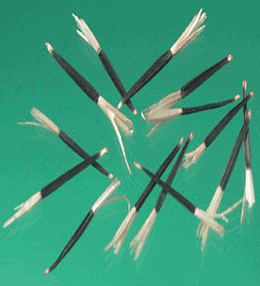 Marigold seeds (left),
Marigold seeds (left),
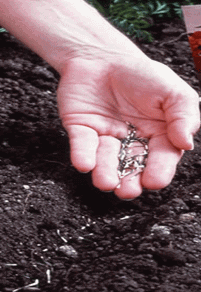
Sowing of Marigold seeds
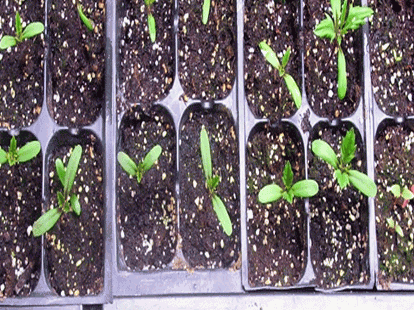 Marigold seedlings in tray
Marigold seedlings in tray
Transplanting of marigold seedlings:
Marigold seedlings are easily transplanted and established in the field without much mortality. At the time of transplanting, they should be stocky and bear 3-5 true leaves. Thin and long seedlings do not make a good plant. Very old seedlings are also not desirable. Transplanting should be done in well prepared land and soil is pressed around root zone to avoid air pocket. After transplanting, a light irrigation or watering with rose cane should be done.
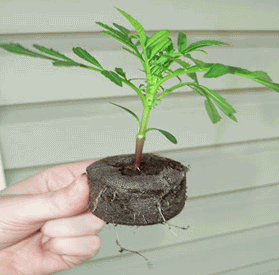
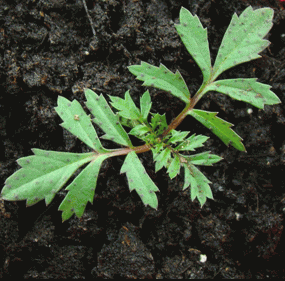
Marigold seedlings ready for transplanting (left) and transplanted seedling (right)
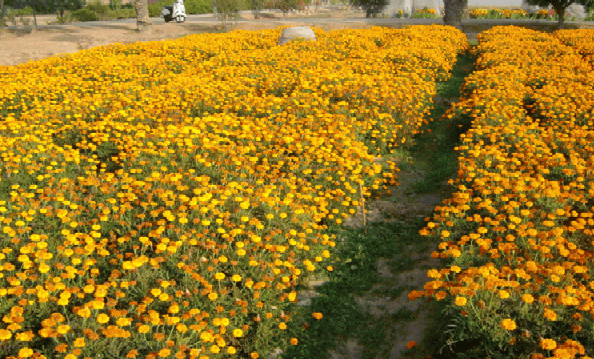 Marigold plants in full blooming stage.
Marigold plants in full blooming stage.
Spacing in Marigold cultivation:
Plant density depends largely upon the growth habit, cultivar and the soil type. In general, spacing should be 30 cm x 30 cm for French marigold and 40 cm x 40 cm for African marigold. Proper spacing between plants is required for better development of plant and higher flower yield.
Manures and Fertilizers:
Since marigold is fast growing crop, it requires high dose of nitrogen and moderate level of phosphorous and potash for better root development and quality flowers. Therefore, 40-50t/ha FYM should be applied at the time of land preparation. In addition to FYM it is advisable to apply 200 kg/ha nitrogen and 80 kg/ha each of phosphorous and potash for good flower yield. The full dose of phosphorous and potash should be given before transplanting while nitrogen is given in two split doses (30 and 60 days after transplanting).
Weeding, hoeing and irrigation:
Weeds are a major problem in marigold especially in rainy season crop. If the weeds are not removed in time, a great loss would occur in terms of growth and productivity of marigold. Normally 3-4 manual weeding and hoeing are required to check weed growth and to keep the field clean. Irrigate the crop in 7-8 days interval, but the frequency and quantity of water also depend upon soil and season. In lighter soil, more frequent irrigation is required than that in heavy soil.
Pinching:
Pinching (removal of terminal portion) is done as breaking of apical dominance mechanically to promote laterals and increasing the number of flowers. In African marigold pinching is recommended after 30-35 days of transplanting.
Diseases and Pests of marigold:
Marigold is relatively free from diseases and insect pests. However, occasionally the following diseases and insect-pests have been observed.
Table3. Important diseases and pest, their symptoms and management of marigold
| Diseases/ Pests | Symptoms and damage | Managements |
| Damping off Rhizoctonia solani | Brown necrotic spots and girdling on the radicle, later on extends to plumule and causes pre-emergence mortality. | Infected seedlings are pulled, sterilization of soil with Formalin@ 2% or Captan 2g/ litre of water. |
| Leaf spot and blightAlternaria sp., Septoria sp., Cercospora sp. | The minute brown circular and brownish-grey spots appear on the leaves. | Spraying fungicides regularly. |
| Collar and root rotPellicularia filamentosa, Pythium ultimum, Sclerotinia slerotiarum | Rotting of root and collar portions is noticed in nursery stage which resulting in wilting of the plant. | Soil sterilization and controlled watering. |
| Flower bud rot Alternaria dianthi | Buds are shriveled, turn dark brown and dry up. Symptoms are less prominent on matured buds but these buds also fail to open. | Spraying Dithane M- 45 and Ridomil @ 2.5g/lit of water. |
| Bud caterpillarsHelicoverpa armigera and Phycita sp. | Eggs are laid singly on young buds. Larvae feed on developing flowers by damaging florets. Larvae of Phycita sp. feed on heads of buds and flowers. | Collection and destruction of infested buds and flowers. |
| AphidsAphis gossypii | Aphids mainly infest lower surface of flowers and base of petals. Nymphs and adults suck the sap from the flowers causing discolouration and withering. | 2-3 sprays of Imidachloropid solution 0.25%. |
Harvesting and Yield of Marigold:
Plucking of flowers at proper stage is important during harvesting to keep the flowers fresh for a longer time for export purposes. Marigold flowers are plucked when they have attained the full size. Plucking of flowers should be done in cool hours of the day either in the morning or evening. Flower yield in both types varies with cultivars, cultural practices like planting time, spacing and fertilizers. The flower yield in African marigold ranges from 125-150q/ha whereas, it is 80-120 q/ha in French marigold.
Authors:
Anop Kumari and Mahesh Choudhary
Department of Horticulture, College of Agriculture,
CCS Haryana Agricultural University, Hisar, Haryana, 125 004
Email:
